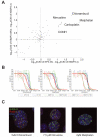A high-throughput pharmaceutical screen identifies compounds with specific toxicity against BRCA2-deficient tumors
- PMID: 20008842
- PMCID: PMC2802735
- DOI: 10.1158/1078-0432.CCR-09-2434
A high-throughput pharmaceutical screen identifies compounds with specific toxicity against BRCA2-deficient tumors
Abstract
Purpose: Hereditary breast cancer is partly explained by germline mutations in BRCA1 and BRCA2. Although patients carry heterozygous mutations, their tumors have typically lost the remaining wild-type allele. Selectively targeting BRCA deficiency may therefore constitute an important therapeutic approach. Clinical trials applying this principle are underway, but it is unknown whether the compounds tested are optimal. It is therefore important to identify alternative compounds that specifically target BRCA deficiency and to test new combination therapies to establish optimal treatment strategies.
Experimental design: We did a high-throughput pharmaceutical screen on BRCA2-deficient mouse mammary tumor cells and isogenic controls with restored BRCA2 function. Subsequently, we validated positive hits in vitro and in vivo using mice carrying BRCA2-deficient mammary tumors.
Results: Three alkylators-chlorambucil, melphalan, and nimustine-displayed strong and specific toxicity against BRCA2-deficient cells. In vivo, these showed heterogeneous but generally strong BRCA2-deficient antitumor activity, with melphalan and nimustine doing better than cisplatin and the poly-(ADP-ribose)-polymerase inhibitor olaparib (AZD2281) in this small study. In vitro drug combination experiments showed synergistic interactions between the alkylators and olaparib. Tumor intervention studies combining nimustine and olaparib resulted in recurrence-free survival exceeding 330 days in 3 of 5 animals tested.
Conclusions: We generated and validated a platform for identification of compounds with specific activity against BRCA2-deficient cells that translates well to the preclinical setting. Our data call for the re-evaluation of alkylators, especially melphalan and nimustine, alone or in combination with the poly-(ADP-ribose)-polymerase inhibitors, for the treatment of breast cancers with a defective BRCA pathway.
Figures




References
-
- Futreal PA, Liu Q, Shattuck-Eidens D, et al. BRCA1 mutations in primary breast and ovarian carcinomas. Science. 1994;266:120–2. - PubMed
-
- Miki Y, Swensen J, Shattuck-Eidens D, et al. A strong candidate for the breast and ovarian cancer susceptibility gene BRCA1. Science. 1994;266:66–71. - PubMed
-
- Wooster R, Bignell G, Lancaster J, et al. Identification of the breast cancer susceptibility gene BRCA2. Nature. 1995;378:789–92. - PubMed
-
- Tavtigian SV, Simard J, Rommens J, et al. The complete BRCA2 gene and mutations in chromosome 13q-linked kindreds. Nat Genet. 1996;12:333–7. - PubMed
Publication types
MeSH terms
Substances
Grants and funding
LinkOut - more resources
Full Text Sources
Other Literature Sources
Molecular Biology Databases
Miscellaneous

